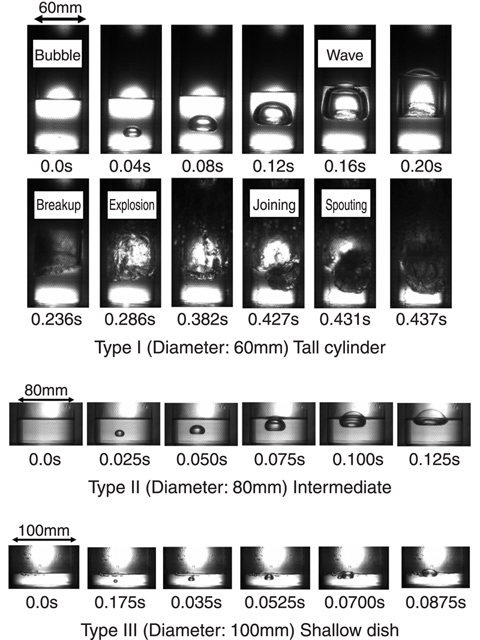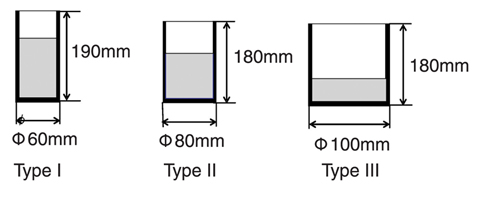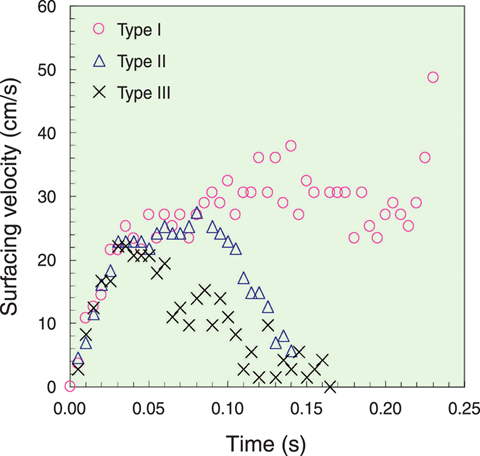
Fig.1-26 Observation of spouting caused by MH

Fig.1-27 Experimental vessel (3 types)

Fig.1-28 Method for estimation of bubble surfacing velocity

Fig.1-29 Surfacing velocity of bubble (Different vessels)
It is absolutely necessary for practical realization of FBR to decrease the cost as well as increase the speed and volume of production of MOX fuel to be burned in the reactor. A turn table system which employs a cylindrical vessel for the de-nitration was proposed as one of the design candidates for these purposes in the Project Phase II which was finished in 2004. It became necessary to quantitatively compare this idea to the former proposals employing a shallow dish, and to judge their feasibility
So, the fundamental sequential mechanism from micro-scale boiling, expansion with surfacing, explosion, and spouting, which causes the de-nitration, was observed by "particle image velocimetry" (PIV) in water subjected to microwave heating (MH). In case of familiar heating like a gas range, a tiny bubble appears at micro flaws on the heated surface and then the water boils at 100°C. This process is called boiling based on "non-uniform nucleation". If the surface of vessel is perfectly smooth, however, no tiny bubble is generated until the water is heated up to 300°C. This phenomenon is called super heating. After this bubble generation, boiling suddenly starts, this phenomenon being called flushing or explosion. This process is called the boiling based on the "uniform nucleation".
On the other hand, in case of MH, the boiling occurs at 100°C with a little super heating. This is due to the peculiar property of energy supplied by the microwave irradiation; namely, micro boiling can start anywhere in the water, being independent of the condition of vessel's surface. This peculiar property of MH was made clear through joint research between JAEA and University of Tsukuba, for the first time anywhere in the world.
It can be seen from Fig.1-26 that the nature of the steam explosion is considerably different according to the configuration of the vessels shown in Fig.1-27. In Type I vessel (tall cylinder), a single micro bubble is generated and surfaces due to the energy stored underneath the bubble as it expands. When the head of the bubble reaches the water surface, break of the bubble and violent spouting occur simultaneously. This sequential action is repeated by following micro bubbles.
In Type II vessel (intermediate), the phenomena from generation of a micro bubble to its expansion is almost the same, but the head of the bubble rises much higher than water surface. When it breaks, a violent explosion occurs and many large size secondary bubbles are generated at the water surface, resulting in violent waves, but no spouting occurs. In type III (shallow dish), the amplitude of the waves remains low and no spouting occurs.
In summary, the tall cylinder causes spouting, while the shallow dish and intermediate type are free from spouting. This fact clarifies the essence of spouting, that the energy accumulated underneath the bubble, which becomes the driving power, increases with the surfacing path length, i.e. the water depth, demonstrating the superiority of the shallow dish.
Fig.1-29 shows the surfacing velocity of a bubble calculated by the method shown in Fig.1-28. As is clear from this, the surfacing velocity is 20cm/s in a shallow dish, and 50cm/s in a tall cylinder. We are now attempting to analyze the relation between surfacing velocity and spouting height.
As the next step in this development work, we are constructing de-nitration apparatuses for Pu/U mixed nitrate solution, to decide which has the best performance on samples with different physical characteristics.
<Previous: 1-10 | Next: 2 Research and Development on Geological Disposal of High-Level Radioactive Waste >